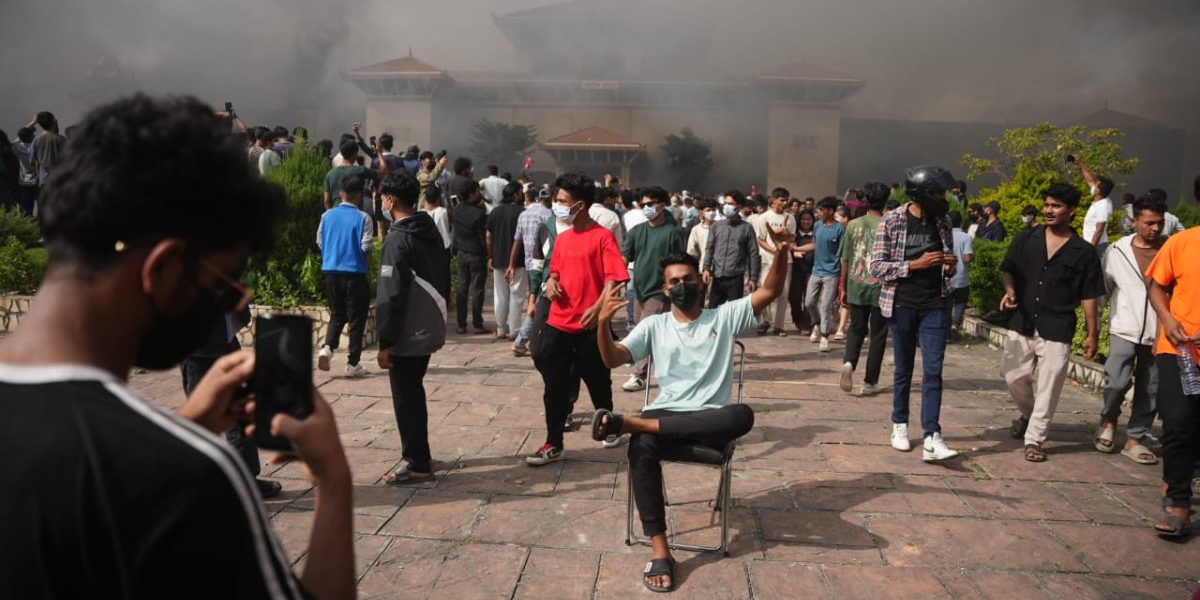From The Wire (Sep 19, 2025)
With institutions torched, an unlikely interim government led by former Chief Justice Sushila Karki has emerged – leaving Nepal’s democracy wounded but not broken
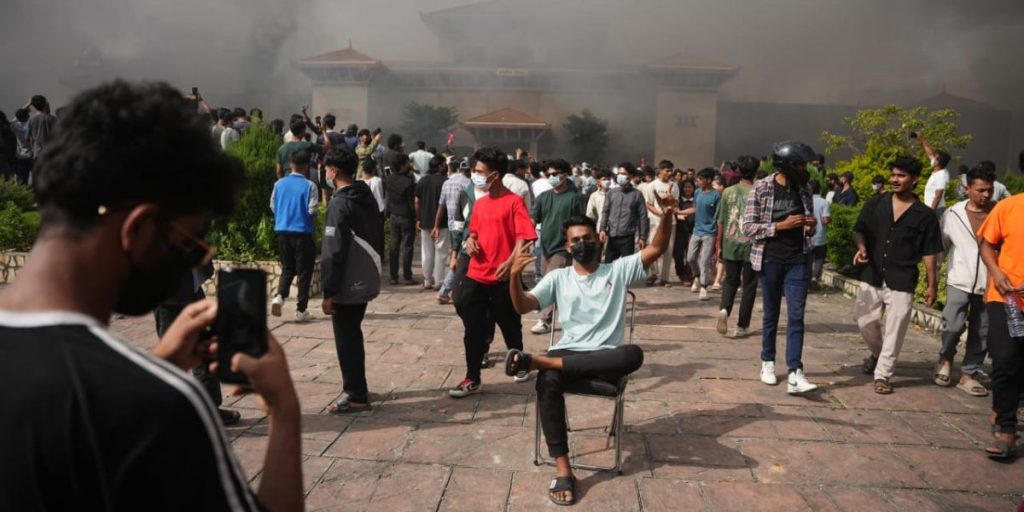
Amidst a fluid situation in Nepal, with the Nepali Congress (NC) and NCP-United Marxist Leninist (UML) of the ruling combine on the back foot – the killings of September 8 having occurred under their watch – It took a few days for their cadres to regroup. But with the main leaders incommunicado, it was too late for them to try and stop the disbandment of the lower house and the formation of an interim government as negotiated between the president, Army and a determined ‘Gen Z’ flank.
There is the suggestion that, by themselves, the Gen Z groups would have been able to muster less than the huge mass that gathered on the ground on September 8. Ex-king Gyanendra Shah’s anointed representative of sorts was the provocateur entrepreneur Durga Prasai, who tried desperately to make common cause with Gen Z and the Army chief Ashok Raj Sigdel, though unsuccessfully.
Over two days, the mainstream political cadre were forced underground amidst targeted threat to life and limb, and hence unable to influence the rapidly evolving dynamic among the Gen Z supporters who efficiently used group chat apps, including Discord, to mobilise.
The disparate Gen Z groups seemed to coalesce around a non-profit called Hami Nepal, led by Sudan Gurung (36), who had earlier described himself as merely a facilitator of the youngsters’ rally of September 8. The main individuals who gave the call for the rally had somehow been pushed into the background, which is another story that has yet to be written.
Unlike the royalists who hoped for the very collapse of the 2015 constitution, the Gen Z and their non-establishment forces abandoned the initial desire for constitution dissolution but stood firm on disbanding the lower house of parliament, including on the advice of Mayor Balen Shah, to disallow the mainstream parties a pulpit.
They agreed on the need for an interim government which would organise elections within six months on a fixed date, as required by the constitution. The longer term goal of the politically-minded would be to generate a two-thirds majority to dismantle the secular, federal and republican frame, and a large number would want a directly-elected national executive.
This is also the position of Mayor Shah of Kathmandu, who has proved influential among the Gen Z groups. While the new forces now hope to take advantage of the unpopularity of the two large parties, the announcement of March 5, 2026, as the election date also allows sufficient time for the older parties to regroup.
As far as elections are concerned, the September 8 killings have certainly tarred the UML and NC, which held the prime ministerial and home ministry portfolios, respectively. Neither ex-Prime Minister K.P. Sharma Oli, nor former home minister Ramesh Lekhak can evade accountability to the extent of holding those positions.
For its part, the RSP will have to try and explain the legality of Rabi Lamichhane’s extraction from Nakkhu Jail and own some of the responsibility for the escapees countrywide that has left communities everywhere unprotected. The Gen Z groups cannot evade responsibility in sharing their perspective as to what went wrong on September 8 after their demonstration was over, and whether some of their own did aid and abet the infiltrators and participate in the destruction of the day after.
As the dust settles, questions will also be asked about the sagacity of asking school-going minors to attend a public demonstration.
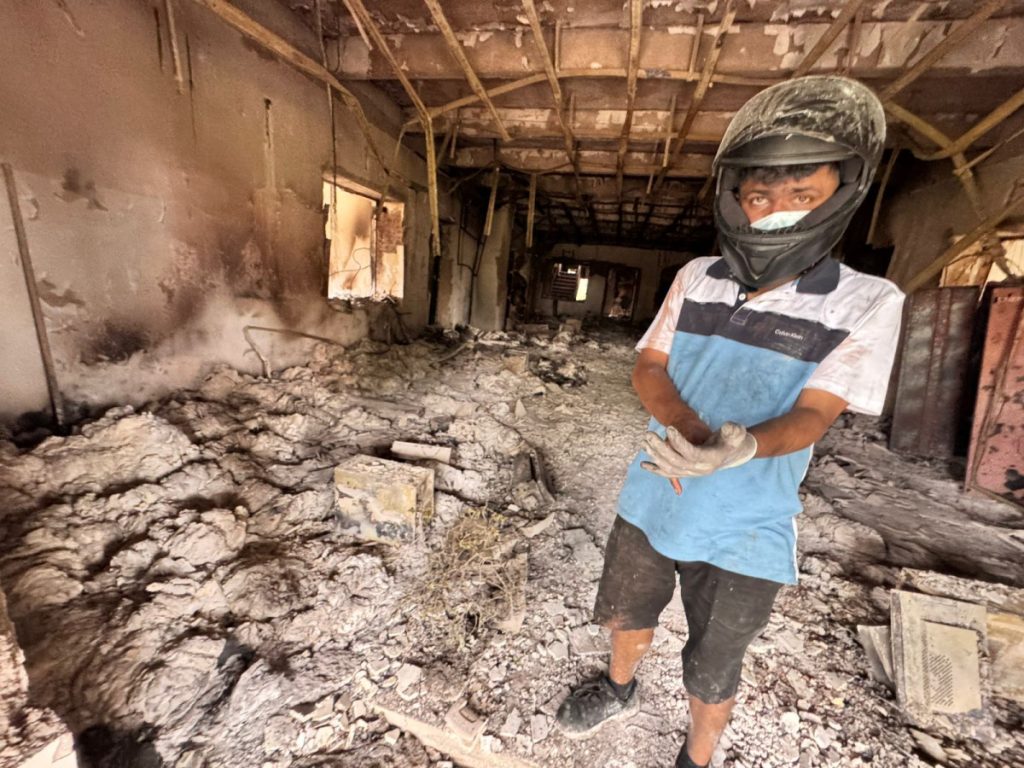
President Paudel
Incredibly, amidst the week of distress and debate following September 8, President Ramchandra Paudel was nowhere to be seen, offering neither authority nor reassurance to the nation. He did not address the nation, and bypassed in the initial negotiations with Gen Z representatives which happened in the Army’s Bhadrakali Headquarters.
It is likely that he was kept under tight security by the military, initially for protection amidst the rioting, but later perhaps to allow time for the generals to manoeuvre with regard to the final denouement. Regardless, on September 14, the president came out with a carefully crafted signed statement which, read between the lines, indicates the he had to use all his guile to work between the army and the clamouring youth representatives to save the constitution and parliamentary democracy.
In his brief statement, president Paudel stated:
“With great effort, a peaceful release has been achieved for the country from an extremely agonising, unexpected and dangerous situation. The constitution has been saved, parliamentary democracy has been saved, and the federal democraci republic is maintained. The people now have the opportunity to proceed towards an even more advanced democracy through elections to the house of representatives within six months. I request all sides working on behalf of the people to show self-restraint and contribute to the holding of the 5 march elections, making use of an opportunity which has been achieved through great skill.”
While the President was working things out with the generals and the Gen Z representatives, thousands of youth on group chat apps were debating who was to be their choice as prime minister. At first, they chose ex-chief justice Sushila Karki (73) as their interlocutor and she rapidly became the prime ministerial candidate of Gen Z – an indicator that they were focused on experience rather than be fixated on age.
Known to be headstrong and uncorrupt as a judge, she was certainly a better option than a raft of pretenders. While her blunt talk has often been off-putting for the mainstream political leaders, who she distrusts, she has ethical boundaries and a commitment to civil rights that have not been questioned. As such, it is hoped that she will be able to talk back as required, both to the Army, unrestrained followers and colleagues, as well as to foreign interlocutors.
Interim PM Karki
The large mainstream parties began showing their presence on September 10, when UML leaders Pradip Gyawali and Shanker Poudel spoke up, as did the party’s secretariat. The co-general secretaries of the NC, Bishwa Prakash Sharma and Gagan Thapa stated in a joint statement that same day:
“The President must hold discussions with all parties while seeking to solve the present crisis. We should not go out of the constitutional track, and any new political structure cannot be created outside due process.”
Amidst the curfew and fearful atmosphere, they also broadcast powerful video messages.
By September 12, proving that Nepal’s civil society was not dead, as suggested by many, there was a flood of statements and positions from diverse sectors, human rights groups, intellectuals of all colours, the Bar, the indigenous rights groups and others around the country speaking up for the constitution. They asked President Paudel to stand by the document rather than be pressured by the urgings of Gen Z representatives for immediate interim government formation.
Word emerged late on September 11 that the president was meeting with constitutional lawyers in the presence of Army Chief Sigdel, which transmitted a sudden message of calm to the intelligentsia.
At least some of the constitutionalists came away from that meeting reassured that the president himself would chair the transitional government, making someone like Karki vice-chair and chief executive of the government, and to announce elections which would ipso facto have dissolved the House of Representatives. Their suggestion was not to go the Bangladesh way of last August when the PM Sheikh Hasina’s departure from Dhaka, dissolved the parliament through explicit announcement following the Bangladeshi president’s discussions with the heads of the three military wings, student leaders and others.
However, President Paudel was evidently unable to withstand the pressures from the Army and the Gen Z groups. While the Army officers apparently warned that an emergency would have to be declared if he did not act on appointing Sushila Karki, Gen Z representatives went into an instantaneous social media campaign for dissolution of the lower house, intent on establishing facts on the ground. It did not take President Paudel more than a day to go along.
Nepal had experimented with a non-parliamentarian head of government back in 2013, when the sitting Chief Justice, Khil Raj Regmi was made prime minister to oversee elections. That was when a provision existed for such a departure from the 2007 interim constitution, whereas no such provision exists in the 2015 document. To find a convoluted way out, President Ramchandra Paudel announced that in consultation with Prime Minister Oli in hiding (and his resignation letter in absentia), and the general powers vested in him to protect the constitution, he was appointing Karki as interim prime minister.
As per the agreement with the president, Army and Gen Z representatives, interim PM Karki immediately announced dissolution of the lower house and the set the date for elections as March 5, 2026.
Immersion course
As far as the Gen Z entities who called the initial demonstration are concerned, their demands for transparency, good governance and non-corrupt leadership, was of course on target. This had long been a concern of civil society generally, one that had been ignored by the political class and successive governments. While many of the participants at the rally were school and college students, more information will, doubtless, emerge in the days ahead about the background and agenda of the organising groups and their promoters. Their ability to change the course of the evolution of the Nepali polity requires embracing their achievements, even if information is sought on their origins and goals.
There is credible information that, by themselves, the Gen Z groups would have been able to muster about two or three thousand people on the ground on September 8. Whether it was by invitation or otherwise, to swell the numbers, ‘reinforcements’ seem to have arrived from the RPP, RSP and Maoist parties, as well as Durga Prasai’s contingent, to make up more than 12,000. That, in fact, may help explain the unplanned march on parliament which turned so deadly, as it was not part of the announced Gen Z agenda.
Sadly, the ultimate sacrifice of so many young activists killed in police firing was driven largely out of focus amidst the violence of the following day and the pitched political contestation that followed, and is bound to continue.
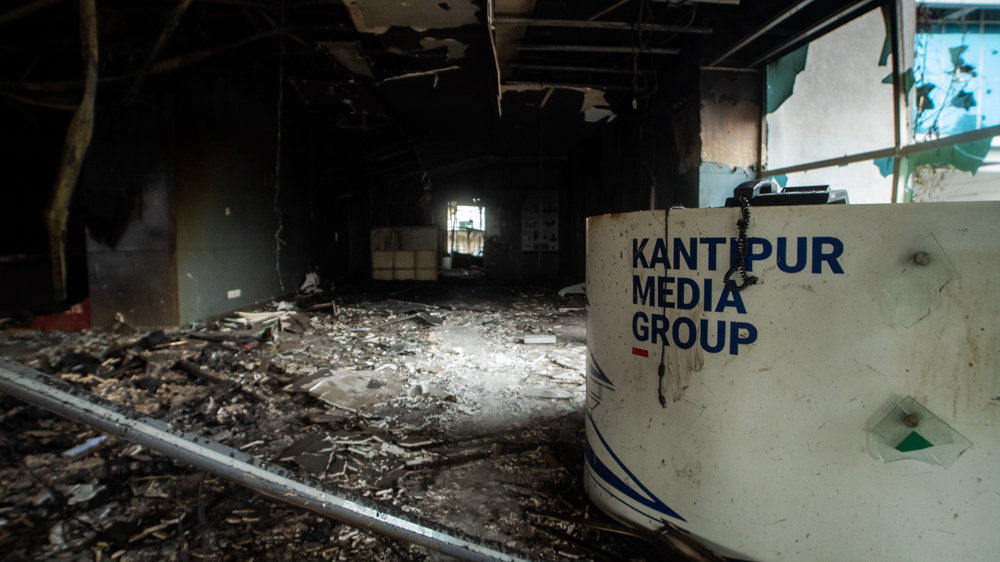
A study of the social media handles of groups professing Gen Z identity shows that several started taking the name ‘Gen Z’ after September 7. At least one large and prominent Facebook group’s past names indicate commitment to political Hindutva. However, it was the Hami Nepal (‘We Nepal’) group which surged to the forefront after September 8, having been started (as evident from its website, which is in English) in 2015 to support earthquake victims, followed by activism during the Covid-19 pandemic.
The leader of Hami Nepal, Sudan Gurung emerged as the key player in openly shared chat group discussions and the voting that led to the ultimate ‘voting’ that proposed Sushila Karki as the Gen Z’s choice for interim prime minister. The fact that Mayor Balen Shah had put his weight behind Karki may have swung the youth vote in her favour. The centrality of Hami Nepal was also evident in the pride of place given to Gurung and his group in the swearing-in ceremony of September 12 evening.
Sadly, the event had none of the gravitas of a national occasion and, as seen on television, it trailed off like a loose gathering of friends in an NGO gathering. Incidentally, none of the political parties were represented at the ceremony other than the Maoist without-a-following, Baburam Bhattarai.
The Gen Z activists are certainly tech-savvy, and are able to use digital tools to grab and spread information near and far. One does not know if many of the activists have commitments beyond the professed grievances that led them to organise the three-hour dharna of September 8, what principles or ideologies they hold dear, or their understanding of history, geography, politics and geopolitics in a society where these subjects are not really taught in schools or colleges anymore.
One could say, however, that the events of the past week would have provided the bloggers, podcasters, content-creators, influencers, as well as lay members of the Gen Z category an opportunity to seek out political context and comparative experiences. In short, as members of a generation that was said to profess disdain for party politics, they are being positively politicised through this ongoing ‘immersion course’ on state and society, despite the extreme physical and emotional toll.
Further, learning from the ‘colour revolutions’ of Eastern Europe, as well as recent movements in Sri Lanka, Bangladesh and Indonesia, one hopes that Nepal’s Gen Z activists are alert to the neoliberal and fundamentalist polarisations that could emerge. If it is true, as seems to be the case, that the Gen Z call to the streets of September 8 was hijacked by anarchists that had been lying in wait for such an occasion, the youth activists must express themselves, as also they must on the countrywide violence of the day after.
Further, if the known and unknown forces decide to sabotage the March elections and lead the country towards fundamentalism or authoritarianism, it will be the Gen Z youth who would have to join other democratic demographics to save the day.
Voices for inclusion
To their credit, with the Gen Z representatives having agreed on the interim prime minister under the constitution, the dangers to constitutionalism seems overcome for now, even without the lower house. The hopes of the Maoist leadership that it might be able to fish in troubled waters have been dashed. The Army is more or less back in the barracks. The ex-king has failed to make away with someone else’s movement. Whatever changes are to be made in the constitution will now happen following the elections based on the showing of different parties and ideologies.
While the term ‘Gen Z’ represents an entire generation born between 1997 and 2013 of the Gregorian calendar, one may question which part of Nepal’s demography is represented by those who sat on the three-hour demonstration, and whose leaders suddenly found themselves in position to negotiate with President and Army as to the head of government.
Amidst the rush of events, it is important to know whether the diversity of historically marginalised communities and voices of mountain, hill and plain that contributed to the writing of the 2015 constitution are fully represented within the demographic of the September 8 demonstrators.
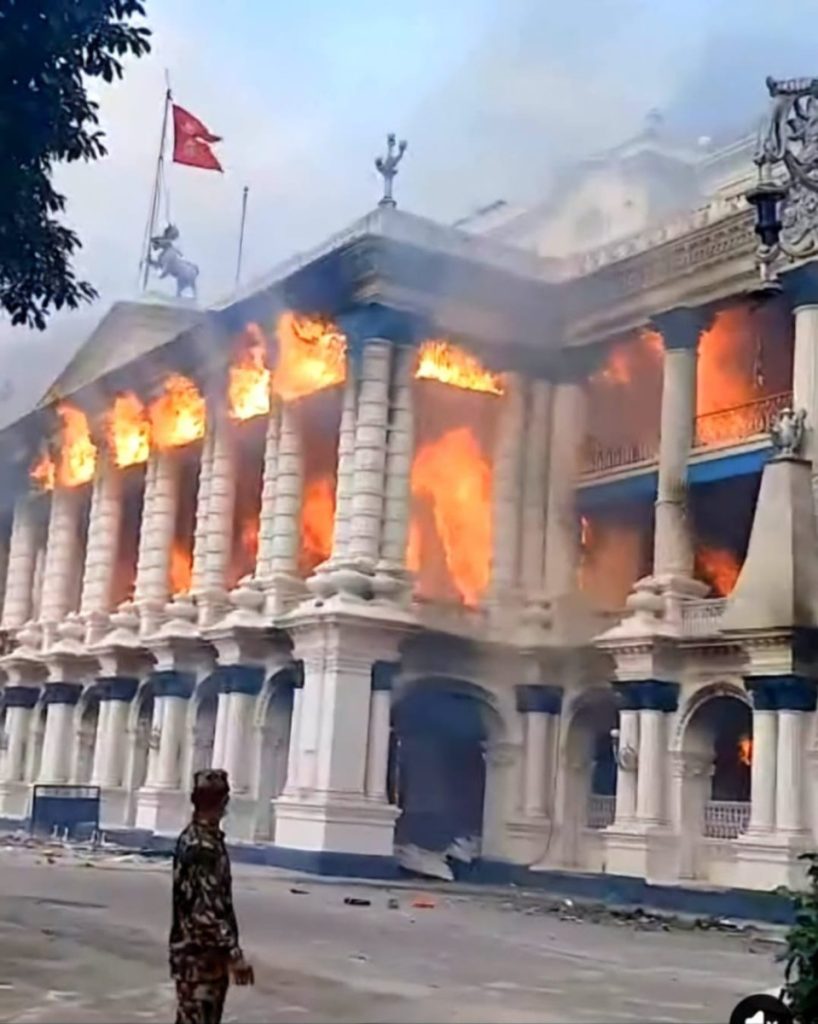
Does the language of the very articulate Gen Z activists include to ‘civil and political rights’ and ‘social justice’? Are the political freedoms that are the legacy of the 1990 constitution, and ‘inclusion’ which is the contribution of the 2015 constitution, in their radarscope?
While individually there would be diverse representation in the Gen Z rallies, going forward and beyond generalities, the activists will doubtless keep in mind the need to understand the hopes and expectations of the Dalit, Janajati, Muslim, Madhesi and others, as well as the disabled, including the ‘Generation Z’ within these categories. Nor should they forget the senior citizens, a large and growing group which should never be forgotten amidst all the talk of ‘youth’.
The concerns of losing hard-fought gains is what made the Federation of Democratic Indigenous Nationalities come out on September 12, warning against attempts to derail the constitution and its provisions.
The investigations into the violence of the past week by the government of interim Prime Minister Karki must start with why the police shoot point blank at protestors on September 8, and why the Nepal Army did not move to stop the mayhem on September 9. The new government may also consider reverting to the previous government’s communications to the international social media platforms, and ask the ancillaries of Meta, as well as X, LinkedIn and others, to register contact points in Nepal.
Build back better
Right now, with the help of the army and its declared curfews, Nepal has achieved a level of calm. The power vacuum has been filled with the announcement of an interim government within the constitution, including the induction of three ministers.
Modern Nepal’s is a society that has suffered 30 years of royal autocracy, a decade of brutal insurgency and the scorched earth response of the state, and been visited by every-decade-or-so calamities including a massacre inside the royal palace, a major earthquake, a blockade, cloudbursts and floods. The events of September 8-9 should not in any way provide an excuse for rule by authoritarians or religious extremists. Nor should the interim government think that it can start prejudicial activities to prevent the NC and UML in their political activities, but such actions are bound to spiral out of control.
Any such attempt would simply mean that a battle for Nepal’s soul would start all over again because 35 years of freedom means that such a pushback towards closed society would ultimately fail. However, much time would be lost, which is why it is significant that the 2015 constitution is extant and the document needs national and international protection.
Beyond the elections of spring 2026, the fight for social justice requires a continuation of the parliamentary democracy introduced by the 1990 constitution and retained in the 2015 constitution, though the latter can and must be amended through democratic negotiation.
The talk of the directly-elected chief executive, which has been bandied about over the past week, was actually the plank of the Maoists when they thought they would convert such a position to long-term state capture. In reality, abandonment of the parliamentary system and placement of a directly elected president or prime minister would not be able to represent Nepal’s diverse population and regions.
It would also make the polity even more vulnerable than it is today to external influence and manipulation. Further, while the 2015 constitution does require revision in numerous areas, as far as the federal provincial structure is concerned, the goal should be to improve its functioning based on the experience of the past decade rather than throw the baby out with the bathwater.
Even though the lower house of parliament has been disbanded under the doctrine of necessity, the speaker is still in his position under constitutional provisions. The upper house remains in place, as is also the case with the seven provincial governments and 753 local governments with their elected leaders and ward officials. It is worth considering that the nefarious plans of the known and unknown agent provocateurs also failed because these representative institutions remain as the foundation.
Parliamentary democracy has only been partially wounded in the search for a practical solution under the doctrine of necessity applied by President Ram Chandra Paudel.
While the constitution does not have provisions to limit the powers of an interim prime minister, the government she leads should clearly concern itself mainly with restoring law and order, organising the March general elections, reconstruction of state and society, and investigations into the violence of September 8-9.
The regular functions of state administrations should continue with more diligence than shown by earlier governments, including revival of the economy and pursuing cases of corruption. Any untoward adventure by the interim government, emanating from any quarter near and far, would be thwarted by the institutions that do exist, in particular, the Supreme Court. For that reason, there is a need to be alert to actions that may undermine the Supreme Court as the institution of last resort.
The NC and UML parties can be expected, for their own survival if nothing else, to defend due process. However, both parties must emerge from the bossism which has defined their functioning of the last few decades. They must extricate themselves from foreign influence and also rebuild their internal democracy, in the process also devolving authority and agency to the provinces and local governments to reflect the federal structure.
The 2025 Gen Z uprising was not the first time Nepal’s youth rose up against the prevailing regime. In April 1979, student-led agitation against the hanging of former prime minister Zulfikar Ali Bhutto in Rawalpindi had forced the royal regime of King Birendra to concede and announce a plebiscite to choose between the ‘reformed’ panchayat system and multiparty democracy.
As someone who fought the royal panchayat regime when it was at its more autocratic, interim Prime Minister Karki is obviously alert to the dangers of non-party (nirdaliya) government; she must therefore strive to form a representative cabinet. Any coercive departure is bound to spontaneously bring the civil society and the people en masse unto the street to protect what has been achieved over three decades, and to prevent a regression to the times of old. Political adventurism would not be a good idea – neither for the government, the Army, nor for political entities old and new.
Nepal should gird up to rebuild anew on the basis of the constitution, with a guarantee of the March 5, 2026, date as sacrosanct. The international community, particularly the near neighbours must heed the fact that in the most distressing of circumstances, Nepal’s people have shown their resolute commitment to the 2015 constitution, multiparty democracy and pluralism.
Post-elections, the political parties in parliament can negotiate amendments to the constitution as per their mandate and ideologies. For the sake of its people, Nepal should not be a country that is in the news because of turmoil, calamity and disaster; we need deliberate steps into the future rather than a faux revolution.
Anarchy should not deliver fait accompli.
The slogan after the 2015 earthquake was ‘build back better’. Carrying forward the push by the young activists of Generation Z, that should happen in the full spectrum of accountable governance, leading towards goals that have long eluded generations past – economic growth, social justice, inclusion and diligent management of international affairs.
It is worth noting that while the Supreme Court and parliament were razed, a brand new Supreme Court as well as parliament building are only months from completion. The newly-elected parliament will have a home, as will the justices of the Supreme Court.
As for the prime minister, she is moving into a brand new building that was originally meant for the home ministry.
Kanak Mani Dixit is a writer and Founding Editor of Himal Southasian magazine as well as a civil rights activist based in Kathmandu Valley. kanakmanidixit.com
This is the second part of a two-part series on the Nepal interregnum. Read part one here.
